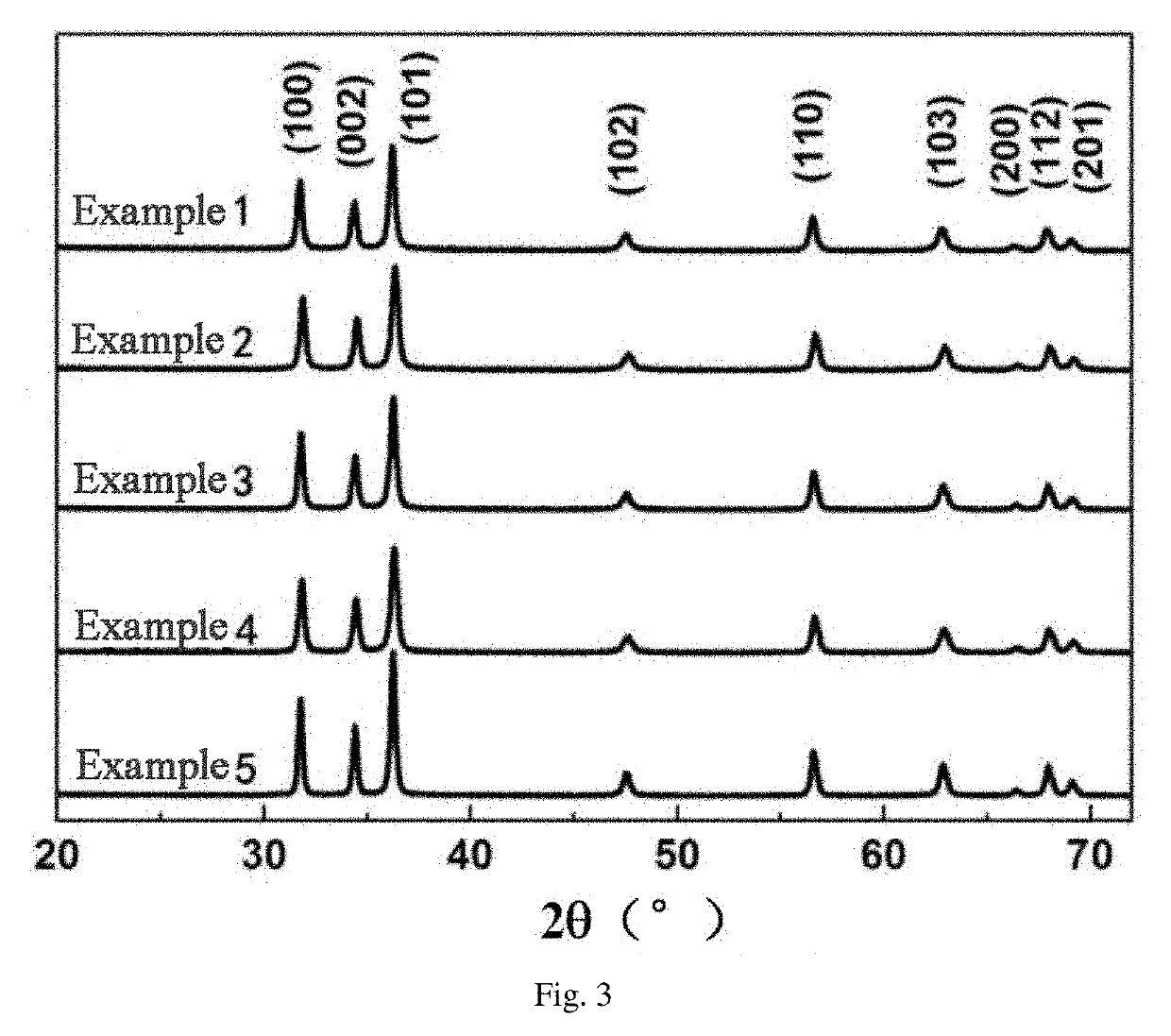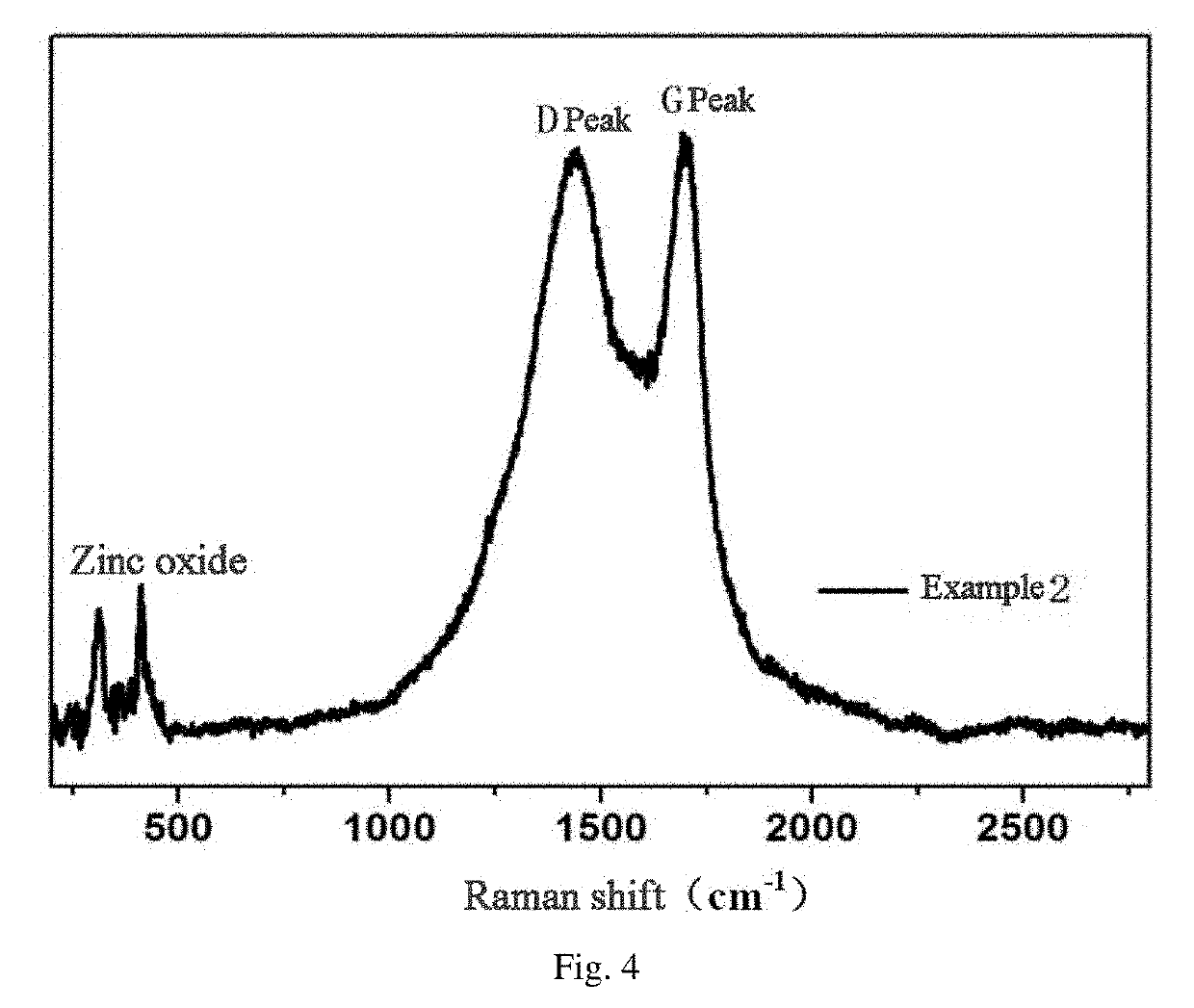Three-Dimensional Lignin Porous Carbon/Zinc Oxide Composite Material and its Preparation and Application in the Field of Photocatalysis
a composite material and zinc oxide technology, applied in the field of organic/inorganic hybrid materials, can solve the problems of difficult handling of industrial wastewater, significant reduction of degradation rate and efficiency, and low photocatalytic activity of zinc oxide, so as to improve degradation efficiency and rate, simple and easy process, the effect of high value utilization
- Summary
- Abstract
- Description
- Claims
- Application Information
AI Technical Summary
Benefits of technology
Problems solved by technology
Method used
Image
Examples
example 1
[0036]5 g of zinc nitrate and 5 g of sodium bicarbonate were respectively dissolved in water to prepare a solution having a mass concentration of 20%, and then the sodium bicarbonate solution was added to the zinc nitrate solution, followed by stirring at room temperature. Then 10 g of wood pulp alkali lignin solid powder was added, and the resulted solution was stirred for 10 min and transferred to a hydrothermal reactor and kept at 70° C. for 8 h to produce a lignin / zinc oxide precursor composite, which was subjected to suction filtration to produce a filter cake. The filter cake was dried in a low temperature oven at a drying temperature of 40° C. for a drying time of 3 h. The obtained solid was ground into a powder, and calcined at 500° C. under the protection of N2 for 3 h, and then cooled to room temperature to produce a three-dimensional lignin porous carbon / zinc oxide composite material.
example 2
[0037]30 g of zinc chloride and 30 g of sodium carbonate were respectively dissolved in water to prepare a solution having a mass concentration of 40%, and then the sodium carbonate solution was added to the zinc chloride solution, followed by stirring at room temperature. Then 10 g of bamboo pulp alkali lignin solid powder was added, and the resulted solution was stirred for 30 min and transferred to a hydrothermal reactor and kept at 90° C. for 8 h to produce a lignin / zinc oxide precursor composite, which was subjected to suction filtration to produce a filter cake. The filter cake was dried in a low temperature oven at a drying temperature of 60° C. for a drying time of 4 h. The obtained solid was ground into a powder, and calcined at 750° C. under the protection of N2 for 1.5 h, and then cooled to room temperature to produce a three-dimensional lignin porous carbon / zinc oxide composite material.
example 3
[0038]15 g of zinc oxalate and 15 g of sodium bicarbonate were respectively dissolved in water to prepare a solution having a mass concentration of 30%, and then the sodium bicarbonate solution was added to the zinc oxalate solution, followed by stirring at room temperature. Then 10 g of wheat straw pulp alkali lignin solid powder was added, and the resulted solution was stirred for 20 min and transferred to a hydrothermal reactor and kept at 120° C. for 2 h to produce a lignin / zinc oxide precursor composite, which was subjected to suction filtration to produce a filter cake. The filter cake was dried in a low temperature oven at a drying temperature of 40° C. for a drying time of 5 h. The obtained solid was ground into a powder, and calcined at 650° C. under the protection of N2 for 2 h, and then cooled to room temperature to produce a three-dimensional lignin porous carbon / zinc oxide composite material.
PUM
| Property | Measurement | Unit |
|---|---|---|
| temperature | aaaaa | aaaaa |
| temperature | aaaaa | aaaaa |
| temperature | aaaaa | aaaaa |
Abstract
Description
Claims
Application Information
 Login to View More
Login to View More - R&D
- Intellectual Property
- Life Sciences
- Materials
- Tech Scout
- Unparalleled Data Quality
- Higher Quality Content
- 60% Fewer Hallucinations
Browse by: Latest US Patents, China's latest patents, Technical Efficacy Thesaurus, Application Domain, Technology Topic, Popular Technical Reports.
© 2025 PatSnap. All rights reserved.Legal|Privacy policy|Modern Slavery Act Transparency Statement|Sitemap|About US| Contact US: help@patsnap.com



